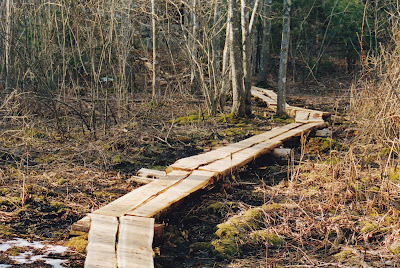 |
| A new split-log boardwalk at Nelson Forest. |
Since 1970, the North and South Rivers Watershed Association has worked for the preservation, restoration, maintenance and conservation of the rivers and related natural resources of our watershed. We have grown from a small group of citizen activists to an organization of over 1000 individuals, families, and businesses dedicated to improving water quality, restoring natural resources, providing environmental education, and facilitating recreational use and access to rivers and open space on the South Shore. For us, 1996 was a year of major accomplishments, considerable improvements and new beginnings.
The year began with a confirmation of success for the stormwater treatment system that we installed at Marshfield’s Riverside Circle in Autumn 1995. By late winter, it was evident that the system, funded by grants from the Mass Bays program and a number of private individuals and business owners, reduced pollution entering the North River by 75-95%.
The subsequent improvement of water quality made it possible for the state Division of Marine Fisheries to reopen 194 acres of shellfish beds at the mouth of the North River on April 2. The shellfish beds had been closed since 1990. The NSRWA viewed this as a great accomplishment, as it marked the success of our Harvest ‘95 project, which aimed to improve water quality in the river to a level which would permit seasonal shellfishing.
The reopening of the shellfish beds also marked the end of Debbie Lenahan’s tenure as NSRWA’s Executive Director. Lenahan chose the occasion of this achievement to step down, and the NSRWA hired Steve Ivas of Norwell to take her place.
Under Ivas’s directorship, the NSRWA took a more active role in community water quality and open space issues. We advocated for protection of Scituate’s town water supply in the First Herring Brook subwatershed, helped plan improvements at Hanover’s Luddam’s Ford Park and Indian Head Canoe Launch, and served as an advisor on the formation of the Pembroke Open Space Committee. We also helped ensure the conservation of the 174-acre Donovan Property in Norwell, and aided the New England Forestry Foundation in creating a management plan for Marshfield’s Nelson Forest. Furthermore, we were an important player in the effort to eliminate a property adjacent to Scituate’s fragile Driftway marshes as a potential site for the layover facility of the Old Colony Greenbush Railroad.
With water quality in the North River restored to fishable, swimmable levels, the NSRWA turned its attention to the other major stream in our watershed, and launched the South River Initiative in September. This endeavor aims to involve business, government and other community stakeholders in Marshfield, Duxbury, Pembroke and Humarock in improving the South River as a resource for all who may benefit from it, whether for recreation, wildlife habitat, real estate, or aesthetic value.
1996 was also a year in which the NSRWA considerably improved the quality of services that we provide to the community. We expanded our calendar of nature walks and paddling trips, offering guided tours of such sites as Cove Creek, the Rexhame Dunes, Herring Brook, Jacobs Pond, and Stetson Meadows, to name but a few. We initiated a series of kayak safety and skills workshops, which we held monthly throughout the summer and early fall on the South River. We co-sponsored an Earth Day celebration for children and adults at the South Shore Natural Science Center, and continued such annual events as River Cleanup Day, The Great River Race, and the Water Watch Forum Series.
We also continued regular testing of water quality of the North and South Rivers and their tributaries through our RiverWatch and Citizen Monitor programs. RiverWatch testing results were published weekly in the Mariner newspapers throughout the summer, providing fecal coliform bacteria levels to indicate which sections of the rivers were suitable for fishing and swimming.
This year we also expanded our community outreach efforts. In May, we began publishing a biweekly “On the Water” nature column in the Mariner newspapers. Thanks to grants from the state Department of Environmental Protection and the federal Environmental Protection Agency, we became involved with public outreach for the cleanup of hazardous waste at the South Weymouth Naval Air Station. In addition, we initiated environmental education programs in the Norwell and Marshfield school systems, providing a citizen activist newsletter for Marshfield’s fourth graders and offering guided forest tours and field trips to Norwell elementary students.
We look forward to further expanding our efforts in 1997. Improving water quality, wildlife habitat, and recreational access on the South River will be our number one priority, but we will not turn our back on the North River — or any of the watershed’s tributaries. We’re planning a subwatershed assessment project of Norwell’s Dwelley’s Creek, ski and snowshoe workshops, canoe and kayak trips, lots of guided nature walks, expanded education programs, and plenty more.
This past year, the twelve communities that comprise the North and South Rivers Watershed have shown tremendous support for the NSRWA. Such support renews and increases our strength. As we step forward into the new year, we will continue to strive toward the goal of a beautiful, healthy, diverse and accessible river environment.
by Kezia Bacon, Assistant Director, North and South Rivers Watershed Association
January 1997
